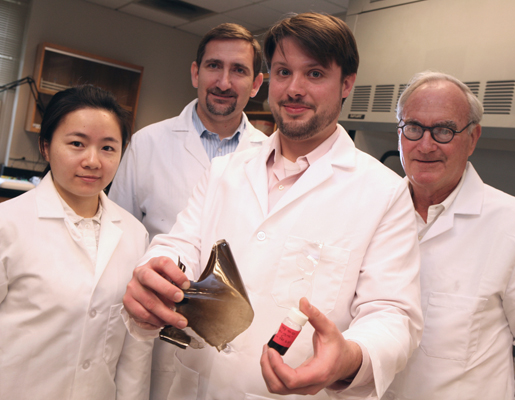Lighter, stronger, better
New graphene oxide-reinforced polymers show bright promise
A group of researchers at the College of William & Mary have made important advances in technology combining polymers—the material of the present—with graphene—the material of the future.
Jaeton Glover, a post-doctoral chemist at William & Mary, explains that the group incorporates graphene oxide into polymers, a process that opens the door for a range of enhanced plastics that are super-strong as well as super-versatile.
The work is detailed in a paper titled “In Situ Reduction of Graphene Oxide in Polymers,” published in the leading polymer journal Macromolecules. Glover is lead author on the article, along with Minzhen Cai, a graduate student in applied science; Kyle R. Overdeep, a graduate student in chemistry, now at Johns Hopkins; David E. Kranbuehl, emeritus professor of chemistry; and Hannes Schniepp, assistant professor of applied science.
“Polymers are something that’s all around us,” explained Schniepp. “Half of the stuff we have is polymers or plastics. The idea is that if we just add something to the polymer—like these small particles of graphene—we can add additional functionality.”
Structural strength is just one example of the functionality Schniepp mentioned. Graphene is a hundred times stronger than steel, in fact it’s the strongest material ever tested by man. Graphene oxide-reinforced polymers could open up a new range of strong, yet light, material possibilities.
“You can make a structure—an airplane wing or a component of a car—and it can give you the strength that you need for your specifications,” Glover explained. “But, because graphene-reinforced polymers are so light in comparison to metal, there is less material there, there is less weight. And then you start talking about fuel efficiency because you’re pushing less material through the air or on the road.”
Another property of graphene offers even more important possibilities for adding functionality to polymers. Graphene oxide has some intrinsic semiconducting characteristics, qualities that can be enhanced by heat treatment, Glover said. He added that the paper outlines some possibilities for controlling the semiconducting qualities by using different thermal treatments. These properties can potentially be exploited for opto-electronic applications, such as solar cells.
“You can have a pretty fine control on the opto-electronic properties of your material,” Glover said. “Once you do that, we’re getting to the point that we can think about designing new kinds of solar cells or printed microchips, and, well, who knows what else?”
The list under “what else” could include some relatively minor enhancements to materials that graphene oxide-reinforced polymers could provide. One example, Glover said, is control of the color of the material. He notes that such a property isn’t as important as strength and conductivity, but could have some utility for applications such as windows and roof coatings, where screening of sunlight is desired.
Glover points out that graphene oxide-reinforced polymers have two additional virtues for manufacturing. First of all, graphene itself is inexpensive, almost literally dirt cheap. The second virtue is that the incorporation of the graphene oxide into the polymer is relatively environmentally friendly. What makes it green is the way in which the graphene oxide is incorporated into the polymer: the process uses plain old water. No toxic chemicals are required for making the polymer-graphene oxide composite, Glover explained.
“You need to maximize the contact between the graphene oxide sheets and the polymer matrix surrounding it,” Glover said. “One nice way to do that is to disperse it in water so you’ve got these millions and billions of tiny little sheets floating around in there so that you can evenly disperse it through your polymer.”
The College has a pending patent on this innovative process, and Jason McDevitt, William & Mary’s director of technology transfer, is optimistic about the potential.
“It’s a really neat approach to incorporating graphene—and all of graphene’s beneficial properties—into polymers,” McDevitt said. “The method is simple and robust, and we are hopeful that it will be utilized commercially.”















